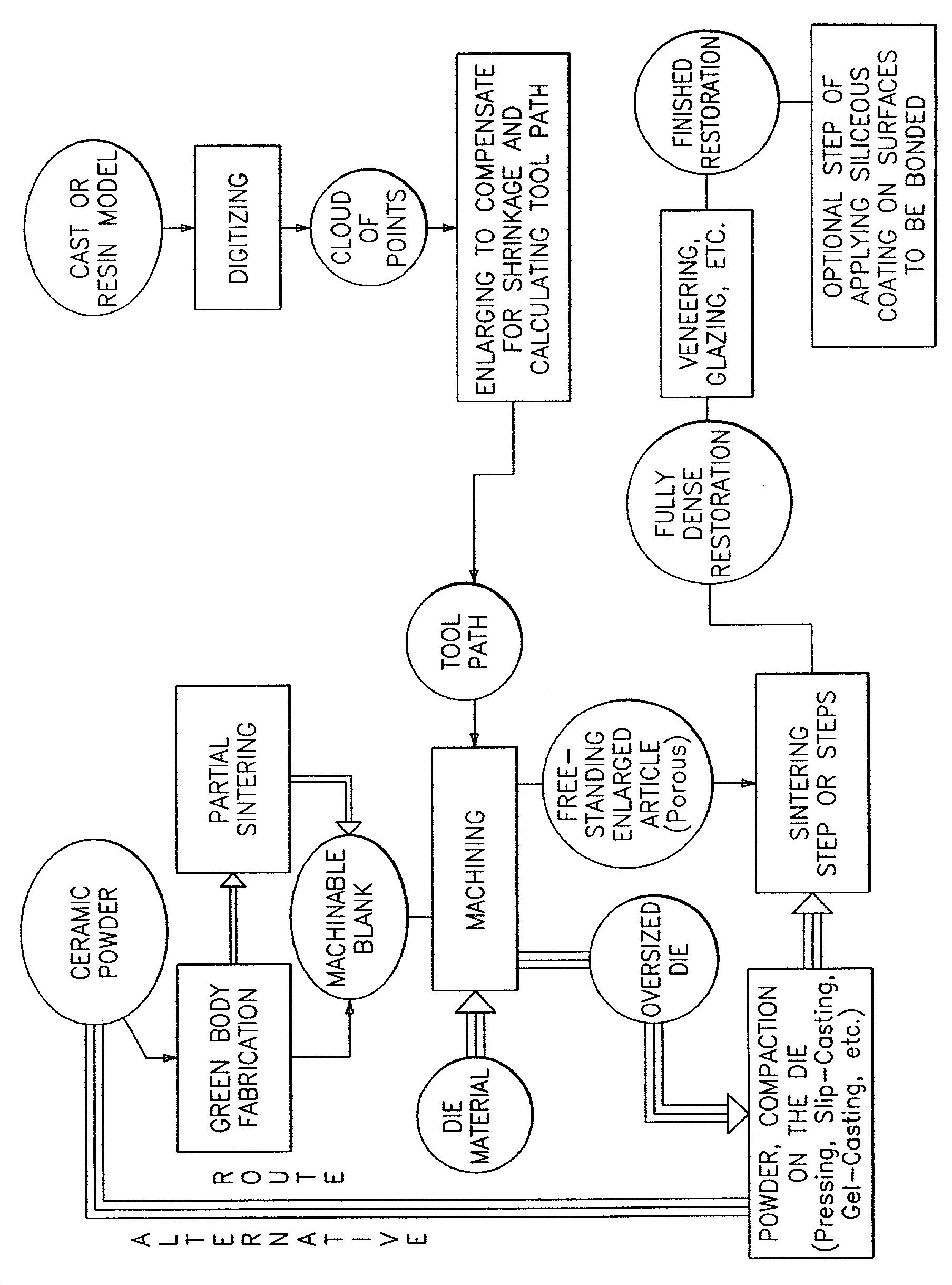Methods of producing dental restorations using CAD/CAM and manufactures thereof
a dental restoration and camera technology, applied in the field of allceramic dental restoration manufacturing methods, can solve the problems of affecting strength and reliability, requiring extensive labor and time, and about two hours of concerted effort to complete a crown, etc., and achieves the effect of high strength, high strength and high strength
- Summary
- Abstract
- Description
- Claims
- Application Information
AI Technical Summary
Benefits of technology
Problems solved by technology
Method used
Image
Examples
example 1
[0027]Green bodies of four commercially available materials were cut from large uniaxially pressed plates of one inch in thickness into blocks having dimensions of 1.0×0.6×0.6 in3. The four materials were (1) AD-995 Alumina (99.5% alumina); (2) FG-985 Alumina (a finer particle size alumina); (3) ZTA Zirconia (zirconia toughened alumina); and (4) YTZP Zirconia (four mole percent ytrria stabilized tetragonal zirconia polycrystal). All four materials were supplied by Coors Ceramic Company, Golden, Colo. The blocks were obtained from the supplier in the soft-sintered state. The supplier soft-sintered the blocks using production kilns at various undisclosed firing cycles designated below in Table 1. The soft sintered blocks were characterized by bisque densities ranging from about fifty percent (50%) to about eighty four percent (84%) of theoretical density and corresponding bisque-to-final linear shrinkages and linear shrinkages are tabulated below. Bisque density is equal to a percenta...
example 2
[0032]The same four materials used in Example 1 were used in this example. The soft-sintered blocks were machined into copings using a CAD / CAM file from a previously digitized model. The quality of margins, integrity of edges and ability to withstand handling were evaluated for various bisque densities. The linear shrinkages corresponding to the workable bisque densities for two of the alumina samples and ZTA were established to be in the range of about 10% to about 13%. Materials with linear shrinkage of less than about 9% were found not to be machinable by the dry process with carbide tools. Materials with linear shrinkages of more than about 13% with the exception of TZP were found to be too weak to maintain integrity of edges and withstand handling. Consequently, the linear shrinkages corresponding to the workable bisque densities for two alumina materials and ZTA were established in the range of 10% to 13%. Bisque density is important both to assure optimal machinability and ti...
example 3
[0033]Two of the above evaluated materials, AD-995 and FG-985 were supplied by Coors Ceramics Company (Golden, Colo.) as pre-sintered cylinders having dimensions of about 1.128″ in diameter and about 0.75″ in height. The cylinders were presintered (bisque sintered) at the temperatures listed in Table 2. Corresponding bisque-to-final linear shrinkages at the respective bisque sintering temperatures are likewise set forth in Table 2 below.
[0034]
TABLE 2AD-995BISQUE SINTERINGFG-985LINEARTEMPERATURE ° C.LINEAR SHRINKAGESHRINKAGE122512.8713.30125012.5712.81127511.8712.14130011.3711.57132510.6010.8513509.909.93
[0035]Using a CAD / CAM device and digitizer manufactured by CAD / CAM Ventures, Irving, Tex., the model of the tooth preparation was digitized and the obtained cloud of points was enlarged proportional to the linear shrinkage data set forth in Table 2 to compensate for bisque-to-final sintering shrinkage. The copings were milled from the blocks according to the resulting CAD file. The c...
PUM
 Login to View More
Login to View More Abstract
Description
Claims
Application Information
 Login to View More
Login to View More - R&D
- Intellectual Property
- Life Sciences
- Materials
- Tech Scout
- Unparalleled Data Quality
- Higher Quality Content
- 60% Fewer Hallucinations
Browse by: Latest US Patents, China's latest patents, Technical Efficacy Thesaurus, Application Domain, Technology Topic, Popular Technical Reports.
© 2025 PatSnap. All rights reserved.Legal|Privacy policy|Modern Slavery Act Transparency Statement|Sitemap|About US| Contact US: help@patsnap.com



